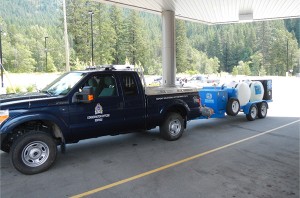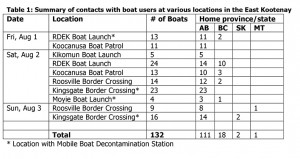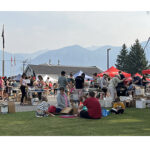Home »

Ongoing boat inspections recommended
An East Kootenay Boat Inspection Blitz conducted during the August long weekend helped raise awareness about Aquatic Invasive Species (AIS) and produced a recommendation to continue with boat inspections in order to continue fighting the spread of AIS.

The East Kootenay Invasive Plant Council, Ministry of Environment (MOE), Ministry of Forests, Lands, & Natural Resource Operations (MFLNRO), and Border Guards with the Canadian Border Services Agency (CBSA) August 1-3 teamed up to stop and inspect boats coming into the region, as well as educate the boat owners about AIS.
In a summary of the weekend campaign, Todd Larsen, Program Manager with the East Kootenay Invasive Plant Council (EKIPC) pointed out that the main objectives of the project were: To familiarize Conservation Officers (COs) with regulations, conduct boat inspections, and take necessary enforcement action. It was also held to raise public awareness of the impacts of AIS, and what measures can be taken to prevent their spread and to build partnerships between the above mentioned agencies.

“The vast majority of boat owners were from Alberta (84%), 14% from B.C., and a few from Saskatchewan and Montana. Many of these boats were used in Idaho, Montana, B.C., and Alberta – areas that currently do not have invasive mussels, but may have other AIS that are not known to be in the waterways of the East Kootenay,” Larsen reported.
“There were an average of 3.9 people per boat, and with a total of 132 boats inspected, approximately 515 individuals were contacted regarding responsible boat transportation practices,” he continued, adding, “Each boat (owner) was given information about AIS, surveyed for their risk potential, and often inspected for plant fragments or standing water. Most individuals were aware of the impacts of AIS and ‘Clean, Drain, Dry’ principles, and were appreciative of our efforts to maintain the ecological integrity of B.C.’s lakes and rivers. Boat inspection stations at neighbouring jurisdictions (Alberta, Idaho, and Montana) have been successful at preventing the introduction of invasive mussels through boater education and regular enforcement.”
The EKIPC is in possession of a mobile boat wash station, which was used in some instances to remove unknown aquatic fragments, and as a demonstration piece for boat owners during the weekend blitz.
“The COs were shown how it can be utilized to decontaminate a boat that is carrying AIS. No vessels were found to be transporting prohibited Aquatic Invasive Species,” Larsen said. “It is recommended that boat inspections are continued at critical entry points such as US/Alberta border crossings and high use boat launches. Coordination with neighbouring authorities (other B.C., Alberta, Idaho, and Montana) is important for clear messaging and sharing of resources.”
Lead image: BC Conservation Officer Jeff Scott washing a boat at the Kingsgate border crossing.
Ian Cobb/e-KNOW







